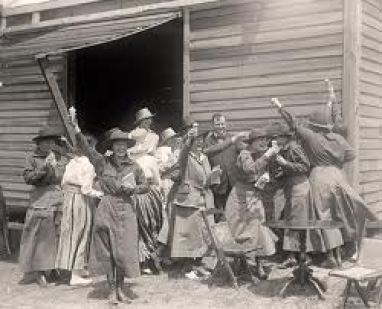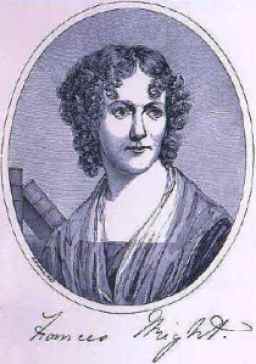
I first heard of Clara Lemlich on the American Experience special “Triangle Fire” about the tragic fire at the Triangle Shirtwaist Factory on March 25, 1911. Prior to the fire, in the fall of 1909, garment workers in New York City went out on a massive strike referred to as the Uprising of 20.000. Clara Lemlich’s words prompted the final decision to strike.
Clara Lemlich was born in Gorodok, Ukraine on March 28, 1886. Her family was Jewish and primarily spoke Yiddish, but against her parent’s wishes Clara learned to read Russian and devoured as many books as she could get. She did sewing and wrote letters for illiterate neighbors in order to raise money for books. It was during this time that a neighbor introduced her to revolutionary literature and she became a socialist.
In 1903, after the Russian Orthodox celebration of Easter, a riot began against the Jews in Kishinev the capital of the Bessarabia province of the Russian Empire (now the capital of Moldova.) The pogrom continued without intervention of the police or military until the third day resulting in approximately 50 deaths, 600 wounded, and 700 houses and businesses looted and destroyed. After this pogrom and a second one in 1905, tens of thousands of Jews left the Russian Empire for the west. The Lemlich family was among them.

Clara immigrated with her family in 1903 to New York City and quickly found work in the garment industry. The conditions in the factories were terrible with low pay, long hours, lack of advancement, and often humiliating treatment from supervisors. The introduction of the sewing machine, rather than making the work easier, served to increase the required output for each day. Workers were often subcontracted and paid even less than those hired directly. Lemlich along with others rebelled against these conditions and joined the International Ladies’ Garment Workers’ Union. She quickly became a leader, organizing strikes and even returning to the picket line after being injured.
On November 22, 1909, a mass meeting was held at Cooper Union to rally support for striking workers at the Triangle Shirtwaist Company and the Leiserson Company. (Clara had been arrested 17 times while picketing outside the Leiserson factory, been beaten, and left bloody on the sidewalk with broken ribs in September.) Leaders in the labor movement and socialist movement spoke for a couple of hours and Clara grew impatient. Finally, she asked to be heard and was raised to the platform. I’ve read a couple of different versions of what Clara said that night. It could be because she spoke in Yiddish and the differences are in the translation, but basically she said that she was tired of talk. She had listened patiently to generalities, but they were there to make a decision, so she moved that they make the decision to strike. The crowd responded and voted for a general strike beginning the next day. Approximately 20,000 workers went out on strike the next day. It lasted until February 10, 1910, with union contracts at most shops. Sadly, the Triangle Shirtwaist Factory held out and refused to make changes or allow the Union into their shop. Then on March 25, 1911, it became the site of a fire that took the lives of 146 people, mostly women and girls.

After the Uprising, Lemlich was blacklisted from the garment industry and at odds with the more conservative leadership in the Union. She then took up the cause of women’s suffrage. She believed that suffrage was necessary to improve working women’s lives. Everyone around them in the workplace, the bosses, foremen, inspectors, and owners, were almost all men and they had a vote, but the working women had no vote. The primary suffrage organization, The National American Woman Suffrage Association, was oriented toward middle and upper class women, so she founded the Wage Earners League as a working woman’s alternative. The Wage Earners League, an alternative to the NAWSA was however, dependent on non-working class women for support. It soon passed out of existence and Clara continued her work for suffrage through the Women’s Trade Union League.
Her life took a different direction when Clara married Joe Shavelson in 1913. They moved to a working-class neighborhood and eventually to Brighten Beach. Clara had 3 children, Irving Charles Velson, Martha Shavelson Schaffer and Rita Shavelson Margules and didn’t return to work full-time for the next 30 years. She didn’t give up organizing however. While she devoted herself to raising her family she joined with other Jewish housewives to protest high prices and fight evictions through rent strikes. With Kate Gitlow, she organized the United Council of Working Class Housewives for this purpose and to raise money for relief for strikers.

During this time Clara had become a member of the Communist Party, from which she launched the United Council of Working Class Women. This organization was very successful for a time with over 50 branches in NYC and branches in Philadelphia, Seattle, Chicago, Los Angeles, San Francisco and Detroit. Although the Council recruited among Communist Party members, it didn’t identify with the Party or press members to join. It eventually was renamed the Progressive Women’s Councils which prompted the Party to withdraw support. Nevertheless in the early 1950s, the PWC was forced to shut down because of Communist Party affiliations.
Clara finally retired from garment work in 1954 and had to fight to get a pension. Over the following years, she was involved in various activities through the Emma Lazarus Federation of Jewish Women’s Clubs, which she helped to found. She protested nuclear weapons and the Vietnam War, and campaigned for ratification of the UN Convention on Genocide and Civil Rights reform.
After her second husband, Abe Goldman, died in 1967, Clara moved to California to be near her children. She moved into the Jewish Home for the Aged in Los Angeles, and even there she organized. She convinced the management to join with the United Farm Worker’s boycott of grapes and lettuce, and organized the workers at the Home. I think it’s safe to say that Clara Lemlich agitated and organized as long as she was physically able. She died on July 25, 1982 at the age of 96
Resources
“One Woman Who Changed the Rules”, Dwyer, Jim (March 22, 2011) New York Times (From this article you can click through to see a series of articles published about the Triangle Fire.)
“Clara Lemlich” – Wikipedia
The 1911 Triangle Factory Fire – Cornell University website
“Remembering the Waistmakers General Strike, 1909” (pdf)
The Labor Wars by Sidney Lens
A People’s History of the United States by Howard Zinn


















































